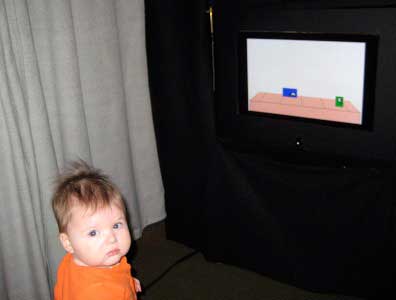婴儿能判断社交场面
knoway于2011-11-03 14:00:45翻译
译言网
准确判断他人之间的关系是在社会上获得成功的关键。无论你是想掌握一定的政权还是想取得更高的社会地位,你都最好能判断出他们谁是领导,谁是部下。最新的研究表明婴儿获得这项能力甚至早于他们学会说话。在1月28日发行的《科学》杂志中,研究人员的报告说十个月左右的婴儿能够感知到社会优势并前预测出谁更可能在发生的冲突中获胜。
在过去的十年中,发展心理学家已经证实了婴儿对周围世界的强烈感知能力。举例来说,在他们接近一岁的时候,婴儿已经能了解到人们有时候会有竞争的目标,注意到一个人是在帮助还是在阻碍他人。
在新的研究中,Lotte Thomsen,哈佛大学的心理学家Susan Carey和她的学生,以及同事们调查婴儿是否也对竞争中更有可能获胜的人抱有一定的期望。他们将144名年龄在八至十六个月之间的婴儿在母亲的陪同下请进实验室。坐在母亲的膝盖上,每个宝宝会观看由两个简单卡通形象扮演的视频录像——每个卡通形象都是长着一只眼睛和一张嘴巴的方块人(看视频)。(心理学家通常用像这些简化了的人物形象代替真实的以避免一些来自面部表情、手势、身体姿势的干扰因素。)
在一次实验中,一些十一至十六个月大的幼儿在观看视频,画面上是一个个头较大的蓝色方块人从屏幕左面跳到右面。接下来一个个头较小的绿色方块人从反方向穿过。于是竞争出现了:两个方块人都准备穿过屏幕并且在中间相撞,谁都无法通过。解决的方法有两种,任何一个方块人向前倾斜,好似在给对方鞠躬,并退到屏幕后方以让对方先通过。
当绿色小方块人为蓝色大方块人让路时,婴儿在放映结束后几秒钟就把视线从屏幕中移开了。但是当绿色方块人先通过时,婴儿注视屏幕的时间平均比第一种情况长了5至10秒钟。Thomsen和他的同事与其他从事婴儿方面研究的研究人员一样,将这多出的注视时间作为婴儿注意到有些地方不合理的证据——这种情况下,婴儿对大方块人会支配小方块人的预期没有实现。
这些研究员作了许多额外的实验试着去排除一些可能的其他解释,包括婴儿是对方块体积的差异作出了不同的反应而不是他们感受到的社会关系差异这种可能性。当研究人员将方块人的眼睛和嘴巴去掉时,婴儿在注视时间上的差异消失了,这证明了婴儿对哪个方块人会取得胜利的预测仅仅适合有人类特征的对象。
在其他一些年龄更小的婴儿的实验中,Thomsen和他的同事发现对注视时间的差异在八至十个月大的婴儿中开始显现,表明了这是判断社会关系的能力开始出现的年龄。
“这是最早发现并证明婴儿在会说话前已经注意到并且通过外貌特征猜测他人之间的在社会关系中所处的地位。” 一位在布达佩斯的中欧大学的发展心理学家Gergely Csibra如是说。
耶鲁大学的发展认知科学家Karen Wynn同意这项研究为先前的工作开辟了新的方向。“这证明了判断社会关系是人生来就有并使之理解这个社会的一项能力这一边缘的理论与实验结果非常吻合,并且个体之间相互作用的意义,”她说,“这种个体之间力量的不对等……也许是我们需要调节的社会基本可变因素之一。
Babies Size Up the Social Scene
by Greg Miller on 27 January 2011, 2:01 PM | Permanent Link | 0 Comments
Share on email EmailShare on print Print|Share on facebookShare on google_plusoneShare on redditShare on stumbleuponMore Sharing Services More
PREVIOUS ARTICLE NEXT ARTICLE
ENLARGE IMAGE
Credit: Lotte Thomsen
Sizing up relationships between other people is key to success in human society. Whether your aim is navigating office politics or climbing the social ladder, you'd better know who's the chief and who's a pawn. A new study suggests that babies acquire this skill even before they learn to speak. In the 28 January issue of Science, researchers report that 10-month-old infants perceive social dominance and can predict who's likely to prevail when a conflict arises.
In the past decade, developmental psychologists have shown that babies are remarkably perceptive about the social world around them. Before the end of their first year, for example, infants understand that people sometimes have competing goals, and they take notice of whether one individual helps or hinders another.
In the new study, Lotte Thomsen, then a graduate student with Harvard University psychologist Susan Carey, and colleagues investigated whether infants also have expectations about who's most likely to get their way when two individuals have conflicting goals. They brought into the lab 144 infants between 8 months and 16 months old, accompanied by their mothers. Seated on mom's lap, each baby watched videos starring two crude cartoon figures—each essentially a block with an eye and a mouth (see video). (Psychologists often use simplified figures like these instead of more realistic ones to avoid confounding cues from facial expressions, gestures, or body posture.)
Blockbuster. Infants' responses to a video starring two animated blocks, suggests that they expect the larger block to dominate the smaller one.
Credit: Courtesy of Lotte Thomsen, Willem E. Frankenhuis, and Susan Carey
More Science News Videos
In one experiment, infants between 11 months and 16 months old watched a video in which a big blue block initially bounces across the screen from left to right. Next, a smaller green block crosses in the opposite direction. Then a conflict arises: Both blocks start across the screen and bump into each other in the middle, unable to pass. The standoff could end one of two ways, with either the blue or the green block tipping forward, as if bowing down, and receding into the background to allow the other block to pass.
When the little green block made way for the big blue block, infants looked at the screen for a few seconds after the clip ended before looking away. But when the little green block actually got its way, the infants stared at the screen for an additional 5 to 10 seconds on average. Thomsen and her colleagues, like many researchers who work with infants, interpret such extra attention as evidence that the infant has noticed that something is amiss—in this case, that their prediction that the large block should dominate the small block hasn't come true.
The researchers did several additional experiments to try to rule out alternative explanations, including the possibility that the infants were reacting to the size difference between the blocks instead of their perceived social relationship. When they removed the eyes and mouths from both blocks, the difference in looking time vanished, suggesting that infants' expectations about which block should prevail apply only to objects with human features.
In another series of experiments with younger infants, Thomsen and colleagues found that the difference in looking time emerges between 8 months and 10 months, suggesting that this is when the ability to detect social dominance comes online.
"This is the very first finding that demonstrates that preverbal infants pay attention to, and guess, the social relations between others on the basis of appearance," says Gergely Csibra, a developmental psychologist at the Central European University in Budapest.
Karen Wynn, a developmental cognitive scientist at Yale University agrees that the study adds a new dimension to previous work. "This fits very nicely with the broader theme of showing that it seems to be part of our inherent human makeup to be attuned to the social world [and] the meaning of interactions between other individuals," she says. "The asymmetry of power between individuals ... may be a fundamental social variable we are tuned to attend to."
http://news.sciencemag.org/sciencenow/2011/01/babies-size-up-the-social-scene.html?ref=hp
www.psychspace.com心理学空间网

